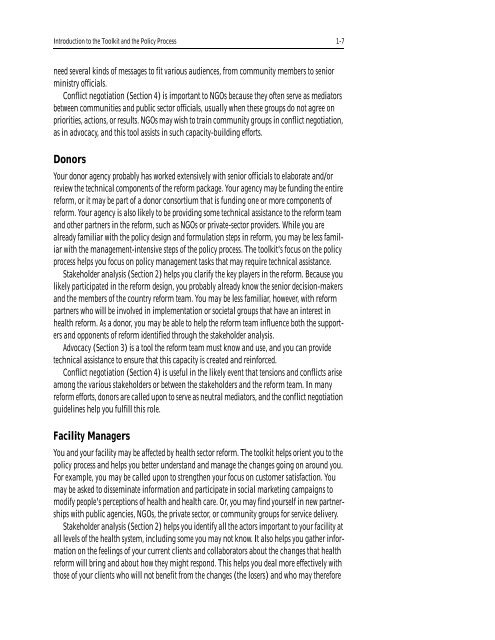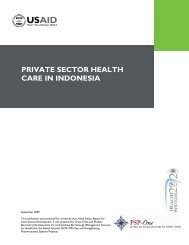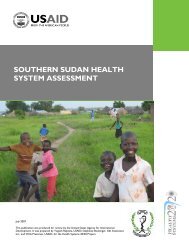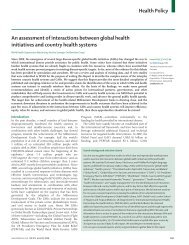Policy Toolkit for Strengthening Health Sector Reform
Policy Toolkit for Strengthening Health Sector Reform
Policy Toolkit for Strengthening Health Sector Reform
Create successful ePaper yourself
Turn your PDF publications into a flip-book with our unique Google optimized e-Paper software.
Introduction to the <strong>Toolkit</strong> and the <strong>Policy</strong> Process 1-7<br />
need several kinds of messages to fit various audiences, from community members to senior<br />
ministry officials.<br />
Conflict negotiation (Section 4) is important to NGOs because they often serve as mediators<br />
between communities and public sector officials, usually when these groups do not agree on<br />
priorities, actions, or results. NGOs may wish to train community groups in conflict negotiation,<br />
as in advocacy, and this tool assists in such capacity-building ef<strong>for</strong>ts.<br />
Donors<br />
Your donor agency probably has worked extensively with senior officials to elaborate and/or<br />
review the technical components of the re<strong>for</strong>m package. Your agency may be funding the entire<br />
re<strong>for</strong>m, or it may be part of a donor consortium that is funding one or more components of<br />
re<strong>for</strong>m. Your agency is also likely to be providing some technical assistance to the re<strong>for</strong>m team<br />
and other partners in the re<strong>for</strong>m, such as NGOs or private-sector providers. While you are<br />
already familiar with the policy design and <strong>for</strong>mulation steps in re<strong>for</strong>m, you may be less familiar<br />
with the management-intensive steps of the policy process. The toolkit's focus on the policy<br />
process helps you focus on policy management tasks that may require technical assistance.<br />
Stakeholder analysis (Section 2) helps you clarify the key players in the re<strong>for</strong>m. Because you<br />
likely participated in the re<strong>for</strong>m design, you probably already know the senior decision-makers<br />
and the members of the country re<strong>for</strong>m team. You may be less familiar, however, with re<strong>for</strong>m<br />
partners who will be involved in implementation or societal groups that have an interest in<br />
health re<strong>for</strong>m. As a donor, you may be able to help the re<strong>for</strong>m team influence both the supporters<br />
and opponents of re<strong>for</strong>m identified through the stakeholder analysis.<br />
Advocacy (Section 3) is a tool the re<strong>for</strong>m team must know and use, and you can provide<br />
technical assistance to ensure that this capacity is created and rein<strong>for</strong>ced.<br />
Conflict negotiation (Section 4) is useful in the likely event that tensions and conflicts arise<br />
among the various stakeholders or between the stakeholders and the re<strong>for</strong>m team. In many<br />
re<strong>for</strong>m ef<strong>for</strong>ts, donors are called upon to serve as neutral mediators, and the conflict negotiation<br />
guidelines help you fulfill this role.<br />
Facility Managers<br />
You and your facility may be affected by health sector re<strong>for</strong>m. The toolkit helps orient you to the<br />
policy process and helps you better understand and manage the changes going on around you.<br />
For example, you may be called upon to strengthen your focus on customer satisfaction. You<br />
may be asked to disseminate in<strong>for</strong>mation and participate in social marketing campaigns to<br />
modify people's perceptions of health and health care. Or, you may find yourself in new partnerships<br />
with public agencies, NGOs, the private sector, or community groups <strong>for</strong> service delivery.<br />
Stakeholder analysis (Section 2) helps you identify all the actors important to your facility at<br />
all levels of the health system, including some you may not know. It also helps you gather in<strong>for</strong>mation<br />
on the feelings of your current clients and collaborators about the changes that health<br />
re<strong>for</strong>m will bring and about how they might respond. This helps you deal more effectively with<br />
those of your clients who will not benefit from the changes (the losers) and who may there<strong>for</strong>e

















